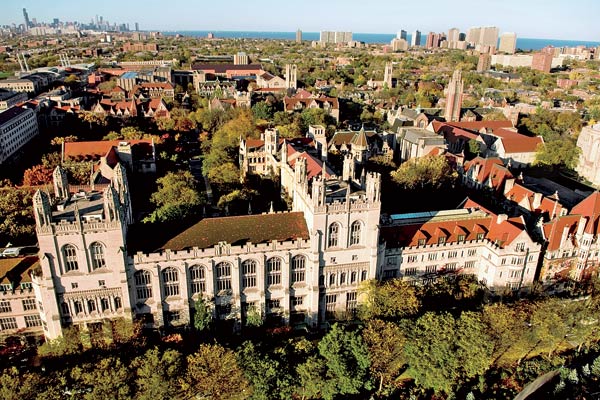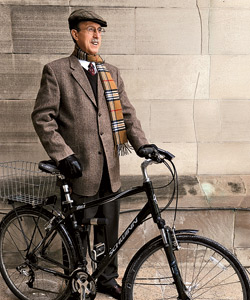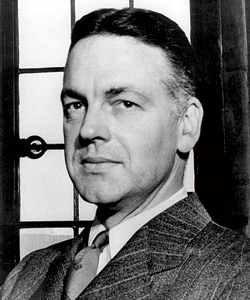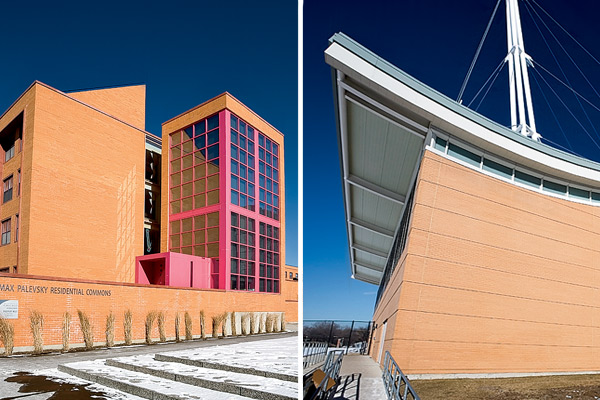 Donald Laackman arrived at the University of Chicago as a freshman in the fall of 1979, having been wait-listed by Yale and rejected by Princeton and Harvard. Though the U. of C. had been his safety school, the young Philadelphian came to admire its intellectual rigor. “There were intense intellectual debates every night at dinner,” Laackman says, “and they would go on sometimes for hours.”
Donald Laackman arrived at the University of Chicago as a freshman in the fall of 1979, having been wait-listed by Yale and rejected by Princeton and Harvard. Though the U. of C. had been his safety school, the young Philadelphian came to admire its intellectual rigor. “There were intense intellectual debates every night at dinner,” Laackman says, “and they would go on sometimes for hours.”
Still, by the end of his sophomore year, Laackman was worn out by the intensity and eager for a breather in the real world. “Ronald Reagan, the pope, and John Lennon had all been shot, and I wanted to make a difference,” he recalls. He left for an internship with a gun-control group in Washington, D.C., even though the dean warned, “You really shouldn’t do that. We don’t like it when students leave.”
After a year off, Laackman returned to the school, but when he later went in search of help finding an after-college job, he got little. “There was no discussion of what you do with your liberal arts degree [other than] grad school or law school,” he says. When the Big Five accounting firm Arthur Andersen scheduled interviews on campus, Laackman recalls, he was the only student who signed up, so the firm canceled.
Years later, when his two children were infants, Laackman told his wife, a University of Illinois alumna, that he didn’t want their kids going to the University of Chicago. “I didn’t want them to go through all the pain I had gone through,” he explains.
For decades, pain seemed an essential element of the U. of C. undergraduate experience—or, in the words of David Nirenberg, a professor of medieval history and social thought, the school was “a locus of the Greek idea that you have to suffer into learning.” And in the 1990s, the school became known as the place “where fun comes to die” after Inside Edge magazine ranked 300 U.S. colleges and universities based on their potential for fun—and the U. of C. came in dead last.
These are not notions likely to lure large numbers of the nation’s most promising high-school seniors, and for a long time the U. of C. lagged behind other top-tier colleges in the number of applications received. But after about 15 years of deliberate changes in everything from the campus landscape and study-abroad opportunities to the pictures in admissions brochures, the U. of C. suddenly finds itself with a status that until recently was almost unthinkable: a hot school. Last year, applications for the 1,350 slots in the university’s class of 2014 totaled 19,340, more than double the number from four years before. Meanwhile, getting in became more than twice as hard: Only 18 percent of applicants got the nod, down from 38.5 percent four years earlier. Going back further, the contrast is even more dramatic: In 1993, when the size of the freshman class was far smaller, 77 percent of high-school seniors who applied got accepted.
The 18 percent acceptance rate doesn’t yet rival the selectivity of the Ivy League and a handful of other elite schools—Harvard took only 6.9 percent of 30,489 applicants in 2010—but it nonetheless places the U. of C. in select company. Duke accepted 14.8 percent of 26,770 applicants, for example, and Northwestern, which has also seen its popularity bloom in the last decade or so, accepted 23 percent of 27,615.
The U. of C. is “one of the top five out-of-state choices for our students,” says Treya Allen, coordinator of college and career readiness at University High School in Tucson, Arizona, picked by Newsweek in 2009 as one of the country’s best high schools. “This year we had about 40 seniors apply, and the University of Chicago is quickly becoming the place to be.”
This past January, the U. of C. announced that applications for the class of 2015 had set another record: 21,669, besting last year’s total by 12 percent. Other measures also reflect the college’s newfound popularity. Yield, or the proportion of students offered admission who ultimately enroll, was up 30 percent in 2009 compared with 1998. And the number of students who leave the college after the end of their first year has steadily decreased, from 12 percent in 1998 to 2 percent in 2010—a clear sign that the U. of C. can not only bring students in but keep them satisfied with life on campus.
In 1996, U.S. News & World Report ranked the U. of C. 11th among undergrad programs at the nation’s elite universities; the school has now been in the top ten for four years, this year tied (with Dartmouth and Duke) at ninth. That’s no small move, notes Bob Morse, the magazine’s director of data research, who’s been involved with its college rankings since the late 1980s. “It takes a lot to move three or four places, because of the competition,” he says.
* * *
Illustration: Nazario Graziano/colagene.com

The Hyde Park campus: a new swimming pool and academic rigor
As dean of the college since 1992, John W. Boyer has quarterbacked the efforts to reshape the place, and he acknowledges that the school set out to create a more alluring and sympathetic environment on campus. “What we haven’t done is tamper with the core of what we do—the basic academic proposition,” he says. “But the wider culture that was around it has been strengthened, understanding that young people need to have support beyond the classroom.”
Part of the U. of C.’s spurt in popularity comes from the mood of the times. The drive to get into selective colleges and universities has grown desperately heated, as high-school students and their parents know. Applications to the best schools are particularly surging (Northwestern recently announced a 10.5 percent jump for the class of 2015). Population trends have something to do with it—more kids are going to college—and the spread of the computer-based Common Application has made it easier for students to apply to more schools. In addition, as one Chicago high-school counselor claims, colleges are going out of their way to encourage applications—bulking up the statistics that go into all-important ratings such as those from U.S. News. “Rankings drive bond ratings,” says this counselor, who asked to remain anonymous because of professional relationships with college admissions offices. “A university’s ability to float debt is often directly linked to how many applications they bring in and how few [of those] students they invite to enroll.”

John W. Boyer, college dean and agent of changeBut the bump at the U. of C. goes further and reflects an effort to make up for a decades-old decision that tilted the university toward graduate students and away from undergrads. This being Hyde Park, the changes haven’t come without argument. Professors, alumni, and others have fretted about the school watering down its famous academic toughness and eroding its longtime strength as a center of graduate-level research. They say a 1990s initiative to make the university more attentive to the bottom line led to a seismic shift in priorities. “It’s degenerating into merely a very good university,” says Marshall Sahlins, an anthropologist who has been at the U. of C. since 1973 and is now semiretired.
But for present-day undergraduates, the campus atmosphere seems greatly improved from the somber attitude that prevailed in Laackman’s day. “This school really engraves in your mind a focus on academic excellence,” says Dalila Johnson, a third-year student from the South Side. “But, you know, we do have a lot of fun, too. A lot.”
* * *
Photography: (campus) Dan Dry; (Boyer) University of Chicago

Robert Maynard Hutchins, who led the university in various roles from 1929 to 1951Talk to the students at the new U of C., and many of them cite as a drawing card one of the old U. of C.’s prime facets: the Core, a Great Books–style series of courses that usually takes the first two years in Hyde Park to complete. “It’s a great thing to be reading Smith, Marx, Durkheim,” says Justina Chung, over lunch in the soaring, wood-paneled Hutchinson Commons, after her Core course called Power, Identity, and Resistance. “When I Skype with my friends at prestigious institutions, some of them haven’t heard of [these] books at all, which I find impossible.” (Right, Justina. That’s Adam Smith and Karl Marx. But Durkheim? Ah. Émile Durkheim, a Frenchman said to be the father of sociology.)
A third-year student, Alexandria Batdorf, from Tacoma, Washington, says the questioning, probing style of teaching carries over outside the classroom. “You go to a frat party and expect to see people dancing,” she says, “but there’s also a lot of talking about Aristotle.”
Liz Pleshette, the director of college counseling at the Latin School of Chicago, says there is a solid population of bright future collegians—and their parents—“who appreciate that the U. of C. does it the old-fashioned way, where they dictate the kind of learning and the exposure to knowledge that you have to have in order to call yourself an educated person.”
Over the years, though, that notion of a select and pure education became so focused and crabbed that it turned into a classic ivory-tower barrier to entry. Dean Boyer traces the image problems on the undergraduate level back to one of the university’s iconic figures, Robert Maynard Hutchins, president from 1929 to 1945 and chancellor from 1945 to 1951.
While it was the founding president, William Rainey Harper, who set the U. of C.’s rise to eminence in motion in 1890 (with the help of the oil tycoon John D. Rockefeller, who donated nearly $35 million—$80 million in today’s dollars—over the next 20 years), Hutchins still casts a very large shadow on campus. Famously, he shut down the university’s Big Ten football program in 1939 (and set the tone for generations of Hyde Park antijocks with his comment, “Whenever I feel the urge to exercise, I lie down until it passes”). More important, he established the school as a beacon of academic freedom just as the Nazis and the Fascists were terrorizing many European universities, and he introduced the Core curriculum—“what we still stand for,” says Boyer, who has written a series of monographs on the school’s history.
But Hutchins also instituted an experiment that Boyer admits was “a disaster for us.” Dissatisfied with the quality of education in the nation’s high schools, Hutchins opened the university’s gates in the 1930s and 1940s to very bright teenagers who hadn’t finished high school. Students as young as 15 could enroll, earn a bachelor’s degree by 19, and start on graduate study.
For a nation quickly building up its industrial might, it made sense to speed supersmart young people into their productive life’s work. Because the U. of C. was the only school to try it, however, “we were way out on the end of a limb,” Boyer says. Many high-school administrators soured on the U. of C. and failed to urge it on their students. And the program had a built-in flaw: “Fifteen-year-olds are not 19-year-olds,” Boyer says. “They have totally different emotional needs. Those classes [during the experiment] had high dropout rates. We got a reputation for being a place that was not particularly friendly to college students.” He says that Hutchins’s successor, Lawrence Kimpton, at one point apologized before a board of Chicago high-school administrators.
After the boom years of the GI Bill (during which virtually all U.S. colleges saw enrollments swell), the U. of C.’s undergraduate enrollment plunged. From 1920 to the beginning of World War II, it had been above 3,000. In 1954, it bottomed out at about 1,300, and it never got above 3,000 again until the late 1980s. Graduate-level enrollment, meanwhile, climbed steadily (except for interruptions during WWII), fueled by the huge expansion of corporate and government funding of academic research that was courted by Hutchins and many others in Hyde Park. Through the 1980s and 1990s, for example, an average of around 6,000 graduate students were enrolled annually. “You end up with a pattern of underinvestment in the [undergraduate] program as the university naturally invests in other things,” Boyer says. “We became very distinguished in doctoral education.”
Graduate students are more mature, more serious, and more focused than undergraduates. As Professor Nirenberg puts it, “Their interests seemingly became the dominant interests on this campus, as you would expect of a graduate research university.”
In 1970, the cerebral attitude that pervaded the U. of C. reached a symbolic crest with the opening of its Joseph Regenstein Library, a brutalist building that looked like a fortress made of mammoth concrete books—and that occupied the former site of the school’s football stadium, Amos Alonzo Stagg Field, which had been demolished in 1957. The new library, says Donald Laackman, became the place where “you could always find your friends on a Friday night.”
* * *
Photograph: University of Chicago

The Max Palevsky Residential Commons (left), designed by Ricardo Legorreta, and the Gerald Ratner Athletics Center, designed by Cesar Pelli. Brightly colored new buildings, a departure from U of C's Gothic architecture, signify the school's efforts to liven itself up.
The university’s dour reputation seeped into the marketplace of high-school students. Among many indicators of the college’s poor draw, the U. of C. trailed its traditional rivals, the Ivy League schools and Stanford, in virtually all admissions measures. Alumni often didn’t encourage their children to apply. The number of students who transferred out after a year or two was comparatively high, and many applicants were using the U. of C. as their safety school, something to fall back on if they didn’t get into one of their dream colleges.
Hanna Gray, the university’s president from 1978 to 1993, tapped Boyer to start the turnaround. “[The university] had struggled for many years to rebuild,” Boyer says, “but there had been a failure to acknowledge that if you were going to solve the problem, it had to be done in a comprehensive way.”
The changes accelerated under Gray’s successor, Hugo Sonnenschein. During his tenure, the consulting firm McKinsey & Company reported that the institution’s financial situation was weak in part because of its focus on graduate research; one of Sonnenschein’s initiatives was to increase the number of undergraduates. As a result, undergrad enrollment has climbed from 3,500 in the mid-1990s to 5,100 this year. (The number of graduate students continued its steady growth to more than 7,000 currently.) The president also rolled out an ambitious building program, and he reduced the number of courses in the Core from 21 to 18.
Sonnenschein faced stiff opposition from a vocal faction of the faculty and resigned in 2000, but many of his initiatives continued under his successors, Don Michael Randel and Robert Zimmer, the current president. In 2001 and 2003, the university unveiled two big, colorful components of the renewal effort. First came the Max Palevsky Residential Commons, with dorm space for 712 students. Designed by the Mexican architect Ricardo Legorreta, it looks as if it might have been assembled from a Technicolor kit of Legos, with its masses of orange brick and its oversize windows with pink, purple, and yellow frames. Two years later and half a block away, the Gerald Ratner Athletics Center, a sports and fitness facility designed by Cesar Pelli, opened. With jaunty curves and masts that stick out at angles, it’s a buoyant counterpart to the campus’s admired inventory of staid Gothic buildings—a visual manifestation of the college’s effort to liven itself up.
Other changes are less brick and mortar. A study-abroad program was created to serve as an organic outgrowth of the U. of C: In 15 cities around the world, students study civilization in a 12-week course with faculty members—or they can take language classes in one of four cities. Even the menu has changed. In Hutchinson Commons, the dining room at the campus’s Reynolds Club, student diners can now get fast food—with oil portraits of John D. Rockefeller and other titans of the school’s history looking on.
And, significantly, after years of a somewhat touchy and distant relationship with its hometown, the college has embraced Chicago. U. of C. student volunteers now tutor children from the Chicago Public Schools, and internships at Chicago companies are encouraged. Boyer even leads bike tours of the city. “When you come to Chicago, you’re not only coming to a great university, you’re coming to a great city,” he says. “The university is situated within a great metropolis; we don’t want our students confined to Hyde Park.”
* * *
The focus on improving undergraduate life has raised new issues. Some on the faculty say there are not yet enough professors or dorm space to suit the continuing growth of the undergraduate population (even with the opening of the 811-bed South Campus Residence Hall in 2009). And at least one veteran faculty member believes the upgrading effort has eroded the university’s longtime strength as a center of graduate-level research. “Undergraduates are income,” says Marshall Sahlins, the anthropologist. “Graduate students are an expense.” By that, he means that undergrads pay to attend the college ($40,188 in tuition this year), while graduate-level researchers largely get paid, in grants and stipends, more than they pay to the university.
Sahlins says that the support for graduate-level research is faltering. In 1993, only about a quarter of all graduate students were in what’s known as terminal master’s degree programs—post-undergraduate programs of one or two years that do not entail doctoral research. Now three-quarters are. “The amount of research [being done] at this university is reduced,” Sahlins says, adding that research funding for graduate students has also declined. In anthropology, 51 of 244 graduate-level applicants were offered departmental funding in 1992, while this academic year, 23 of 286 applicants were.
“This is a reorganizing of the university on a commodified basis,” Sahlins argues. “The whole university has been [subjected to] a cost-benefit analysis rather than qualitatively understood as an academic activity.”
Boyer has been fielding concerns about the U. of C.’s changing nature for years. Shortly after plans were announced to build Ratner, which would include an Olympic-size pool, Boyer says, an alumna asked if the new focus meant they soon would cancel the Core curriculum. “I said I believed we could have both a swimming pool and academic rigor,” he recalls.
The new style on campus has been reflected in admissions publications—obviously, a marketing tool. One current student, who asked not to be identified, offered me an analysis by e-mail. “When I was recruited in Fall 2005,” he wrote, “UChicago’s mailings were very distinctive; they asked that you write haikus about your favorite books and send them in, and the best were posted online. The pitch is now much more generic, and I suppose it has a broader appeal. I’m looking at some current recruiting materials right now, and they’re covered in large photos of smiling students, beautiful buildings, athletic fields. I think that is a pretty fair representation of UChicago. At least it’s much fairer than giving the impression that we only pause our discussion of Kant to roll the Dungeons and Dragons die.”
Among the current students are two whose father—Donald Laackman—once said he would not want his kids to attend. Laackman now speaks admiringly of the feelings of community that envelop his children, the well-organized career planning and placement services, and the opportunities to explore noncurricular interests. He openly admits to envying his kids. “They’re going [to the U. of C.] at a better time than I did,” he says. “It feels very familiar, but with so many things being done better—or being done at all.”
Additional research by Shane Michael Singh
Photography: Steve Geer/istockphoto.com


